

Materials available from LaserSintering.com - Selective Laser Sintering (SLS®), Rapid Prototyping, Rapid MFG. Open SLS: An Open Source Selective Laser Sintering. Lasers and materials in selective laser sintering. PDFdrive.com. Lasers and materials in selective laser sintering. Pdf Ebooks. Web.iitd.ac.in/~pmpandey/MEL120_html/RP_document.pdf. First tests building a powder-based stereolithography printer: part 1. Hi folks, i'm a bit sleepy, but i thought i'd post this while it's fresh: after seeing really interesting powder-based printer designs like this one, that place down a layer of powder then "print" a binding material onto it, i began to wonder (as others have) if we could build a similar setup using ABS powder and a laser diode to fuse the material together. designs like this have a bunch of benefits, including the potential to use the powder as it's own support material.
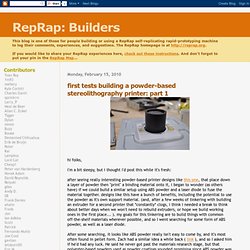
(and, after a few weeks of tinkering with building an extruder for a second printer that *constantly* clogs, i think i needed a break to think about better days when we won't need to rebuild extruders, or hope we build working ones in the first place... ). my goals for this tinkering are to build things with common off-the-shelf materials wherever possible, and so I went searching for some form of ABS powder, as well as a laser diode. off came the cover i put some wire wrap leads on the diode look at that!
Open SLS: An Open Source Selective Laser Sintering Project. SLS wax printer. 3D SLS Wax Printer Release status: Experimental The Reprap and other FDM printers that fabricate in PLA and ABS are restricted both by the limitations inherent in these materials and by the limitations of the FDM process.

Though these printers are entirely capable of self-replication and of producing parts for a variety of light-duty applications, they cannot produce pieces that can replace the cast aluminum parts found in power machinery, CNC equipment, or in numerous other high-strength applications. To address the problem of rapid fabrication in metal, I sidestepped plasma jets, electric arcs, and high-power lasers by opting instead to employ the lost-wax casting technique coupled with a relatively low-power laser sintering system. A complete report on the project with more technical details can be found here and more information about the development of the print material and hardware can be found here.
The SLS process can be described with the following graphic:
Open SLS: An Open Source Selective Laser Sintering Project. Sinterización. Pieza de metal sinterizado.
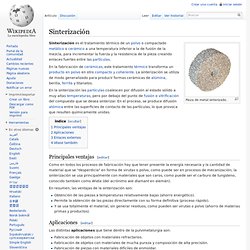
En la fabricación de cerámicas, este tratamiento térmico transforma un producto en polvo en otro compacto y coherente. La sinterización se utiliza de modo generalizado para producir formas cerámicas de alúmina, berilia, ferrita y titanatos. En la sinterización las partículas coalescen por difusión al estado sólido a muy altas temperaturas, pero por debajo del punto de fusión o vitrificación del compuesto que se desea sinterizar. En el proceso, se produce difusión atómica entre las superficies de contacto de las partículas, lo que provoca que resulten químicamente unidas. Principales ventajas[editar] En resumen, las ventajas de la sinterización son:
OpenSLS. OpenSLS: An Open Source Laser Sintering Experimentation Platform Release status: Experimental OpenSLS print emerging from the build chamber.
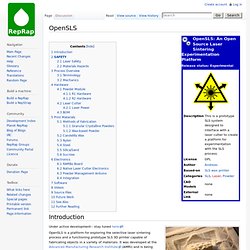
Under active development-- stay tuned here! OpenSLS is a platform for exploring the selective laser sintering process and a functioning prototype SLS 3D printer capable of fabricating objects in a variety of materials. It was developed at the Advanced Manufacturing Research Institute (AMRI) and is being used for research in regenerative medicine and tissue engineering at Jordan Miller's lab for microphysiological systems and advanced materials. This project is unique in that it appropriates existing, affordable laser hardware, namely laser cutters, for use as in the SLS process. Open SLS: An Open Source Selective Laser Sintering. Rapid Prototyping: SLA. The sequence of steps for producing an Stereolithography (SLA) layer is shown in the following figures: Uncured resin is removed and the model is post-cured to fully cure the resin.
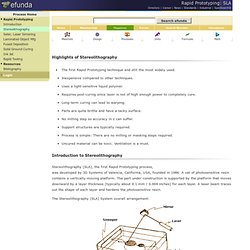
Because of the layered process, the model has a surface composed of stair steps. Sanding can remove the stair steps for a cosmetic finish. Model build orientation is important for stair stepping and build time. In general, orienting the long axis of the model vertically takes longer but has minimal stair steps. During fabrication, if extremities of the part become too weak, it may be necessary to use supports to prop up the model. An Open Source Laser Sintering 3D Printer.
Focus SLS printer by dragonator. Focus has been completely discontinued.

Focus will no longer be updated or improved. It was too slow, to unreliable and the piston design was constantly jamming. Also afters seeing that inkjet printing in powder works really well, I decided that Focus was too slow for further experiments. Selective laser sintering. An SLS machine being used at the Centro Renato Archer in Brazil.
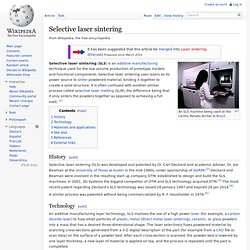
Selective laser sintering (SLS) is an additive manufacturing technique used for the low volume production of prototype models and functional components. Selective laser sintering uses lasers as its power source to sinter powdered material, binding it together to create a solid structure. It is often confused with another similar process called selective laser melting (SLM), the difference being that it only sinters the powders together as opposed to achieving a full melt. [1] History[edit] Andreasbastian/openSLS. SLS 3D Printer. Focus' progress. A Low-Cost Open-Source Metal 3-D Printer. Rapid Prototyping: SLS. Laser sintering. 3D printing could one day be used to replace or repair damaged tissue or bones in the human body.

Researchers at the University of Pittsburgh’s Swanson School of Engineering and McGowan Institute for Regenerative Medicine (MIRM) are hoping to make this dream a reality, and they have proposed a new project, “Additive Manufacturing of Biomedical Devices from Bioresorbable Metallic Alloys for Medical Applications” to investigate the prospect. The new project is one of the 15 selected by the National Additive Manufacturing Innovation Institute, as part of the continued research into additive manufacturing development and research.
As a part of the contract, the team, along with their partners, ExOne, Magnesium Elektron and Hoeganaes were awarded $590,000 for an 18-month period to continue development of 3D printed bone and tissue. SLS wax printer.